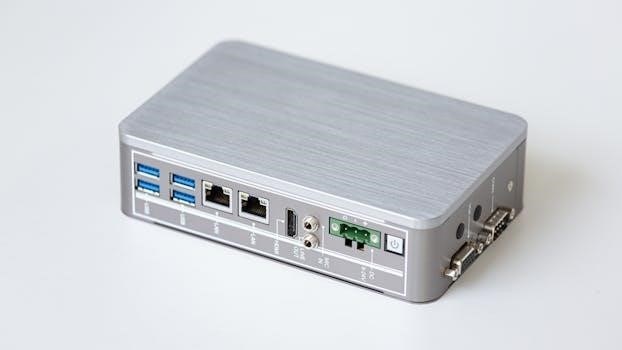Guided Router Overview
Guided routers are essential devices that manage network traffic using specific paths. They ensure data packets reach their destinations efficiently within a defined network. These routers employ standardized protocols and are more sophisticated than bridges, connecting different network types.
What is a Guided Router?
A guided router, at its core, is a network device that directs data packets along specific paths within a network. It’s a more advanced piece of technology than a simple bridge, capable of connecting different types of networks, such as star and token ring configurations. Unlike bridges that rely on hardware addresses, routers operate on network addresses, like IP addresses, to forward data efficiently. This intelligent routing ensures that data reaches the correct destination with minimal delay and congestion. Guided routers use standardized protocols to manage the flow of information, making them crucial for both small local networks and large, complex internet infrastructures. They guide data through pre-determined pathways, ensuring a streamlined and controlled network experience.
Guided Router Functionality

Guided routers function by analyzing network addresses, specifically IP addresses, to determine the most efficient route for data packets. They make use of routing protocols, which define the rules for how data should travel through the network. These protocols ensure that data is forwarded from one router to the next until it reaches its final destination. Routers maintain routing tables, which are dynamic maps of network paths, allowing them to adapt to changing network conditions. This adaptivity is critical for maintaining consistent and reliable data flow. They handle diverse network topologies and can manage complex networks with multiple paths. Guided routers are also capable of implementing security policies, controlling access to network resources and providing a secure data flow.

Types of Guided Routers
Guided routers come in several types, each designed for specific networking needs. These include wired routers, wireless routers, core routers, and edge routers, each with unique capabilities for different environments and applications.
Wired Routers
Wired routers establish network connections using physical cables, typically Ethernet. These routers connect devices through ports, providing reliable and stable data transmission. They are commonly used in home and office settings where a consistent connection is needed. Wired routers are less prone to interference than wireless options; They are ideal for applications requiring high bandwidth and low latency. These include online gaming, video streaming, and large file transfers. They utilize guided transmission media, such as twisted pair cables. These connections ensure a secure and dedicated path for data. Wired routers are generally more secure, as the physical connection limits unauthorized access. They are a fundamental component of network infrastructure, providing a backbone for reliable communication.
Wireless Routers
Wireless routers utilize radio waves to establish network connections, eliminating the need for physical cables. They broadcast Wi-Fi signals, allowing devices to connect wirelessly. These routers are common in homes, offices, and public spaces, providing convenient internet access. Wireless routers offer flexibility and mobility, enabling users to connect from various locations within range. They often support multiple devices simultaneously, making them versatile. The latest wireless routers utilize advanced technologies for improved speed and coverage. They are more susceptible to interference than wired routers, which can affect performance. Wireless security protocols are essential to protect networks. They use unguided transmission media, broadcasting signals through the air. Wireless routers have become increasingly popular due to their convenience and ease of use. They are a staple in modern networking environments.
Core Routers
Core routers are high-capacity devices that form the backbone of large networks. They are used in internet service provider networks and large enterprise environments. Core routers manage massive amounts of data traffic at very high speeds. Their primary function is to facilitate fast data transfers between different network segments. They are typically more powerful and have more processing power than edge routers. Core routers are designed for reliability and redundancy, ensuring continuous network operation. They often use advanced routing protocols to optimize paths for efficient data delivery. Core routers are vital for maintaining the performance of large-scale networks. They need to be highly reliable to support critical network infrastructure. These routers are not common in small networks or home environments due to their high cost and complexity. They use sophisticated hardware and software to handle the vast network traffic.
Edge Routers
Edge routers are positioned at the boundaries of networks, connecting them to external networks. They serve as the entry and exit points for network traffic. Edge routers manage connectivity with other networks, such as the internet. They often implement security features like firewalls to protect the internal network from external threats. These routers perform crucial functions such as routing data to and from networks. Edge routers are the first point of contact for external traffic entering an internal network. They are also the final point of contact for outgoing traffic. Edge routers use various routing protocols to determine the best path for data. These devices are designed to be robust and reliable, handling the critical task of network connectivity. They are essential for ensuring efficient and secure network communication. Edge routers also often perform address translation functions. Unlike core routers, they are commonly found in smaller and medium-sized businesses, and also in larger ones.

Guided Router Features and Technologies
Guided routers utilize specific features and technologies, including router IDs for identification and configuration settings. They employ guided transmission media like cables, and also use various bit types for different applications.
Router ID and Configuration
A router ID is a crucial element for identifying and managing routers within a network. This identifier, often an IP address, enables the router to be uniquely recognized. Configuration of the router involves setting various parameters using a command line or a graphical interface. For example, the “router-id” command is used in router configuration mode, often followed by an IP address to establish the router’s unique identity, such as 192.168.1.1. This configuration process allows network administrators to tailor the router’s behavior to specific network needs. It includes tasks like setting up routing protocols, defining interface parameters, and controlling routing updates on interfaces. Proper configuration is essential for ensuring optimal network performance and security.
Guided Transmission Media
Guided transmission media refers to the physical pathways used for data transfer between network devices. These media consist of physical connections, like wires or cables, that guide the data signals from source to destination. The data follows a bounded channel, ensuring a controlled path. There are three basic types of guided media⁚ twisted pair cable, coaxial cable, and fiber optic cable. Twisted pair cables come in unshielded and shielded forms, each with different performance characteristics. Coaxial cables are known for their higher bandwidth capacity, and fiber optic cables provide the fastest data transmission using light signals. The selection of transmission media depends on factors like distance, bandwidth requirements, and cost.
Router Bit Types and Applications
Router bits are essential tools for shaping wood and other materials, offering diverse profiles and functionalities. Popular types include straight bits for creating grooves and dados, roundover bits for softening edges, and cove bits for decorative concave curves. Chamfer bits create angled edges, while rabbeting bits form steps or recesses. Other specialized bits are available for unique shapes and joints. The selection of a router bit depends on the desired effect and material. Many bits have multiple functions, making them versatile additions to any workshop. Understanding the various bit types is crucial for achieving precise cuts and designs in woodworking projects.

Guided Router Applications and Use Cases
Guided routers are used in home networking for connecting devices, businesses for managing data flow, and specialized applications. They ensure reliable and secure data transmission for various user needs.
Home Networking
In home networking, guided routers play a vital role in connecting multiple devices, such as computers, smartphones, and smart home appliances, to the internet. These routers allow users to share a single internet connection across various devices. They handle data traffic efficiently, ensuring seamless browsing, streaming, and gaming experiences. Wireless routers, a common type in homes, provide flexibility by eliminating the need for physical cables. These devices often include features like parental controls and guest network options, allowing users to manage their home network effectively. Furthermore, they simplify network setup and configuration, making it user-friendly for non-technical individuals. Ultimately, guided routers form the backbone of home networks, facilitating connectivity and communication within the household and the external world.
Business Networking
In business networking, guided routers are crucial for managing complex network infrastructures. These routers handle large volumes of data traffic and ensure reliable connectivity for numerous devices and users. They support various network setups, including local area networks (LANs) and wide area networks (WANs), enabling seamless communication between different departments and locations. Business routers often feature advanced security measures, such as firewalls and intrusion detection systems, to protect sensitive data and prevent unauthorized access. They can also prioritize network traffic to ensure critical applications receive sufficient bandwidth. Moreover, features like virtual private networks (VPNs) enable secure remote access for employees. Guided routers in business environments are designed for high performance and reliability, supporting the critical operations of the organization and ensuring smooth data flow.
Specialized Router Applications
Specialized routers serve unique purposes beyond typical home or business networking. For example, core routers are essential in large networks, such as those used by internet service providers, where they handle significant data volumes and direct traffic across major network paths. Edge routers, on the other hand, connect networks to external networks, like the internet, providing access and security boundaries. Virtual routers offer flexibility and scalability by operating in virtualized environments, allowing for dynamic network management. These routers can be configured for specific tasks, including traffic shaping, quality of service (QoS), and security protocols. They are also used in industrial settings to manage communication between devices and machines, often supporting specialized protocols and stringent reliability requirements. Moreover, some guided routers are designed for specific applications such as mobile networks or satellite communications, emphasizing the varied and essential nature of these devices.
